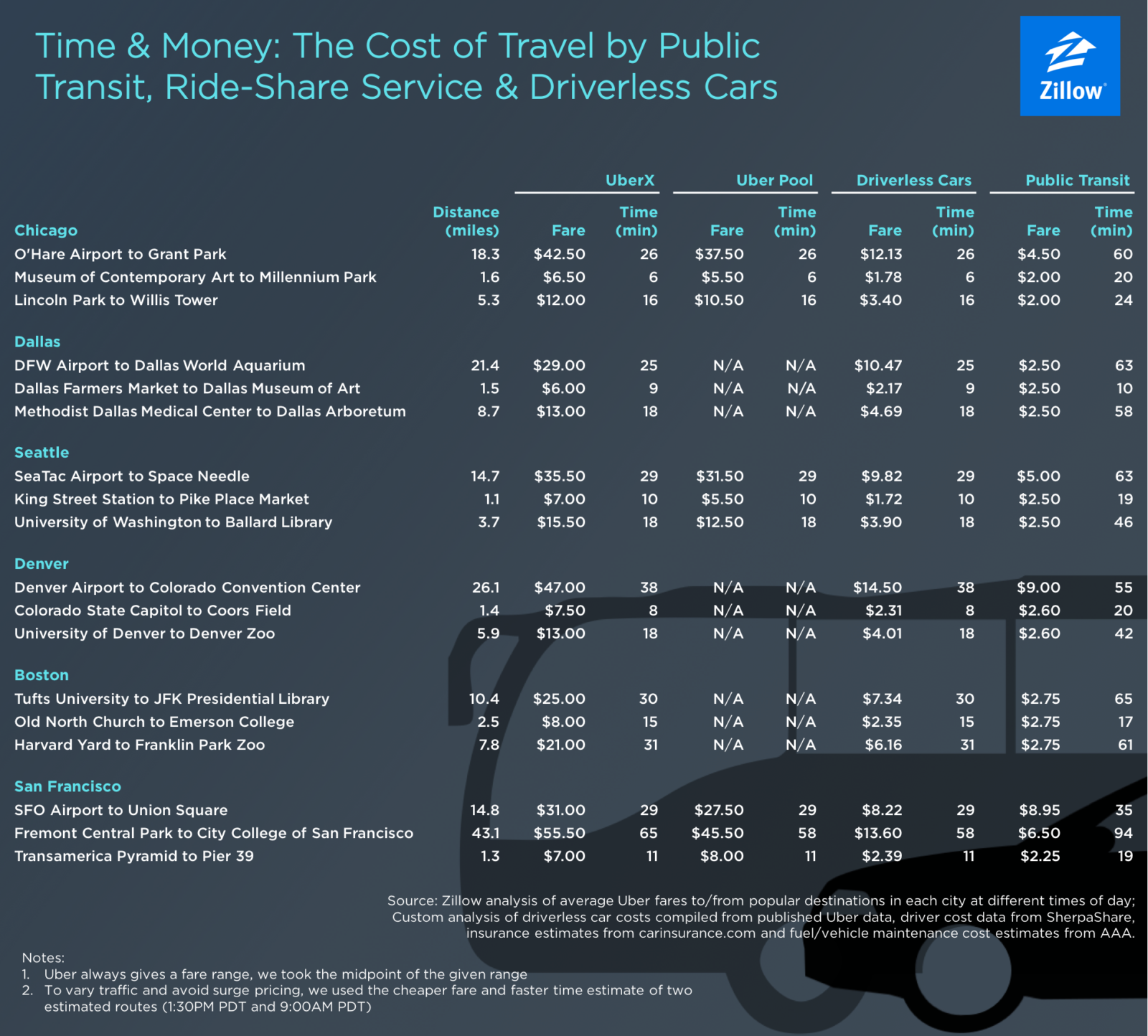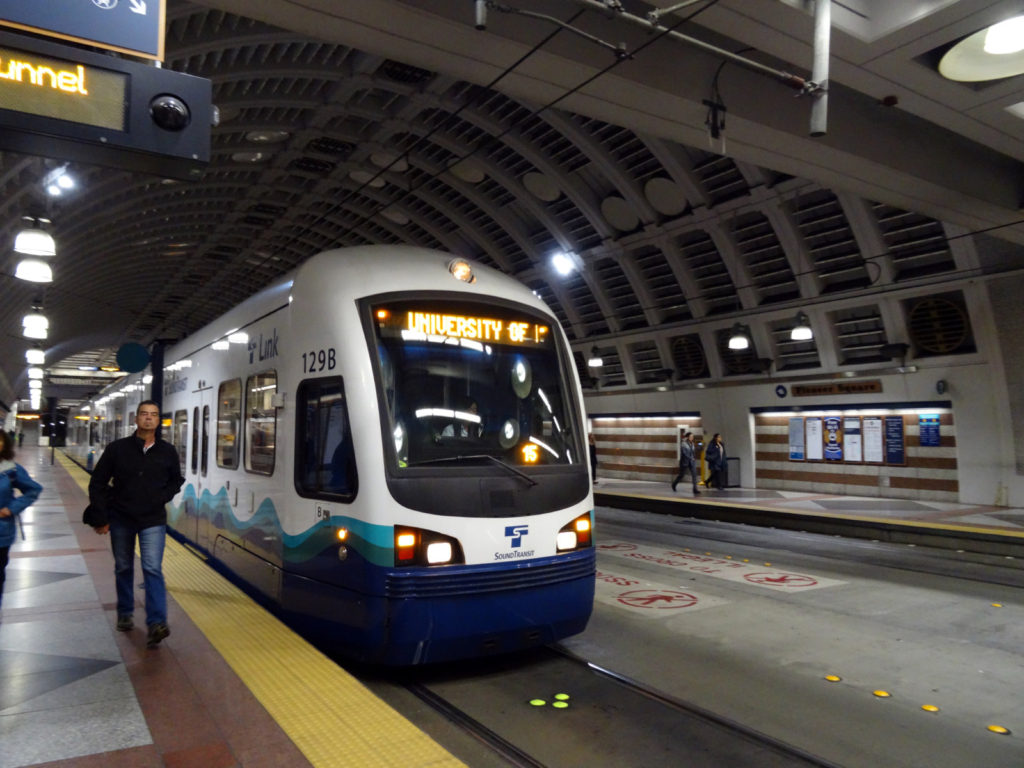Savings on Auto-Pilot: How Much Less Could Driverless Car Commuting Cost?
Thanks to ride-sharing services like Uber and Lyft, the cost of getting a door-to-door ride of a few miles today is less expensive than ever. And looking ahead, switching to a driverless system could eliminate roughly two-thirds of the current cost of a typical Uber ride (even using very conservative assumptions) – helping pave the way for a dramatic re-imagining of public transit planning and affordable community development.
- Driverless cars could save about two-thirds of the costs currently associated with a typical Uber ride.
- Driverless-car costs are comparable to public transit for short and medium-distance trips, and often faster. For longer rides, even driverless cars are unlikely to be cost-competitive with public transit.
Thanks to ride-sharing services like Uber and Lyft, the cost of getting a door-to-door ride of a few miles today is less expensive than ever. And looking ahead, switching to a driverless system could eliminate roughly two-thirds of the current cost of a typical Uber ride (even using very conservative assumptions) – helping pave the way for a dramatic re-imagining of public transit planning and affordable community development.
Zillow combined data from online business management platform SherpaShare with available transit and vehicle maintenance cost data and published data on Uber fares, utilization, trip speed and distance, to analyze the potential cost differences on rides of varying distances taken without a driver. We analyzed data for six large cities as a starting point. And while it’s currently impossible to know which costs currently incurred under today’s manned ride-share system will carry over to a driverless system – if any – we had to make a few basic assumptions, including:
Typically, Uber drivers receive 80 percent of each fare – but not all of that translates into actual, take-home income. After costs including fuel, insurance, maintenance and vehicle depreciation are factored in, drivers actually take home about 70 percent of each fare. Let’s use some basic costs in Boston as a baseline model for how we arrived at our numbers.
SherpaShare estimates the average Uber fare in Boston is $12.80. Using data on the Boston Uber driver utilization rate (drivers have passengers during 46.8% of their shift), and the average speed and distance of Uber trips in Boston (4.4 miles at 19.3 miles per hour), we assume Uber drivers in Boston complete 2.05 trips per hour, on average. If average gross fares in Boston come to $26.28 per hour, and Uber takes its 20 percent, our calculations say drivers bring home an average $21.02 per hour – before expenses.
Using the same data, we estimate Uber vehicles in Boston travel 9 miles each hour at an average of 25 miles per gallon of fuel – fuel the driver is responsible for providing. With an average gasoline cost of $2.34 per gallon in Boston, we add 84 cents per hour from the “driver’s cut” back into the cost of operation. Assuming bottom-line vehicle costs and average lifespan as outlined above, we figure a driverless car will depreciate 6.4 cents per mile and 58 cents per hour. Finally, inferring the current national cost of maintenance and the average insurance premium in Massachusetts, and assuming full-time work, this means we deduct an additional $1.03 per hour spent driving from the driver’s take-home pay. After these costs are figured in, the driver’s hourly wage is closer to $18.56 in Boston, or about 70.7 percent of their gross hourly fares (rather than our 80 percent starting point).
Across all six cities analyzed, we expect between 63.9 percent and 70.7 percent of the costs of current Uber fares could be eliminated in a driverless world. Given these cost savings, it’s possible to imagine a world in which driverless cars enable us to think very differently about how we use transit to help connect low-income communities.
To do this, we compiled fare estimates from Uber (using UberPool data where available) for a few hypothetical routes in each of the six cities examined, and compared those costs with public transit fares.[1] We also included commute-time estimates from Google Maps.

Click to Enlarge
Our results clearly demonstrate that autonomous vehicles can be cheap enough to provide an alternative to, or to supplement, public transit. For shorter trips and middle distances, rides in a driverless car will likely cost roughly the same as a typical trip via public transit. Critically, these trips are also slightly faster, even before accounting for the expected widespread improvement in travel times likely to come within a fully automated city thanks to less congestion and increased road capacity. Still, for longer routes, driverless cars are likely to remain at least somewhat more expensive than transit – about 2.5 times pricier, according to our analysis. For these routes, then, driverless cars may not be a saving grace for low-income households living in more-affordable communities farther away from urban job centers, and other transit types should be considered for moving these employees from home to work and back.
A system that prioritizes high-efficiency and high-speed rail networks to connect farther-flung, more-affordable communities with opportunity-rich cities, then uses driverless cars to shuttle workers and residents to and from rail hubs seems like a good compromise in this case. And within cities themselves, a driverless system will mean less reliance on balky, fixed bus networks and a new abundance of developable land formerly used by parking structures. This could free up more opportunities for sustainable, affordable development.
Related:
[1] To calculate fare estimates, we took the midpoint of Uber’s provided fare range. In an attempt to account for varying traffic rates and surge pricing, we also estimated the fares at two different times per day (9AM PDT and 1:30 PM PDT), and used the cheaper and faster time estimate of the two.

